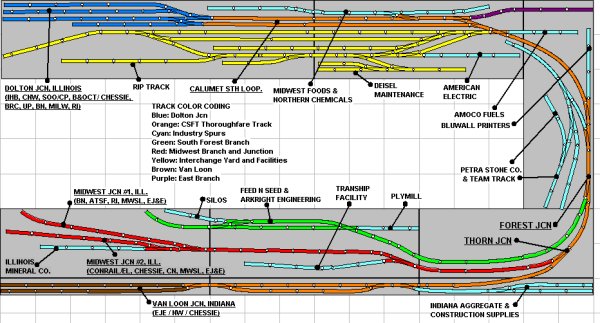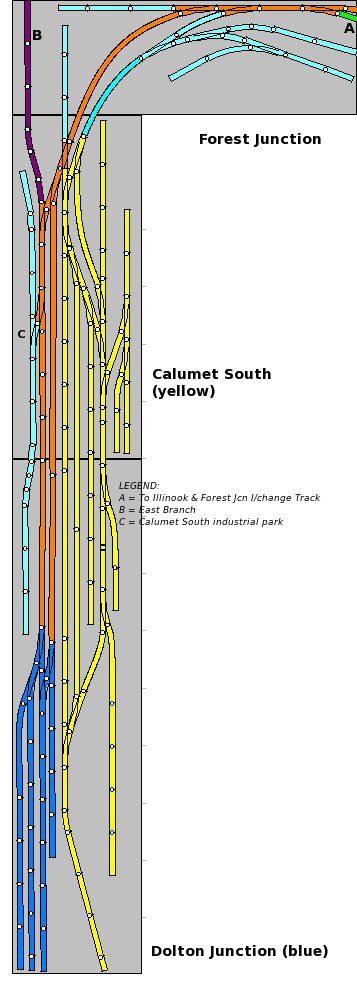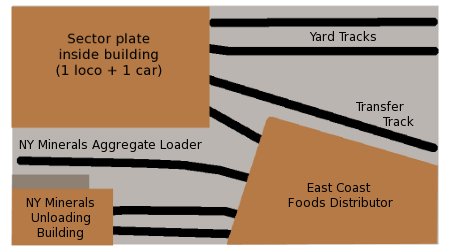Medium, small and micro HO scale layouts including a layout in a suitcase, and modular layouts, all providing lots of switching operation.
Chicago & South Forest Terminal RR
The C&SFT layout was really a ground breaking layout for me as it was my first point to point layout, my first shelf type layout, and my first layout designed around the flexibility of DCC. During the life of the C&SFT RR layout it grew considerably, and could be set up in a number of configurations depending on available space. The mistakes I made on the previous layouts mentioned here all seem to have been avoided on the C&SFT RR layout. Not only that, I have had some decent multi-operator operating sessions on the C&SFT layout – something that always seemed out of reach on all previous layouts up to that time.
This was the next layout after P&RR RR, and was always designed as a switching / industrial layout. It was also designed to be fairly easily moved, as it was built in modules no larger than 6 feet long and 2 feet wide. It went through a few stages:
- Early Construction – 8×6 feet L shape
- Adding of 2 branch lines and more yard space – 14×18 feet L shape.
- Adding an extra branch and staging area, extending yard trackage – 20×10 feet U shape.
- Scrapping of most of the branch lines trackage – 17×6 feet L shape. Also included the construction of the Illinook module, which was made to connect at the end of the L.
- Scrapping the remaining trackage. The C&SFT becomes a fallen flag.
At it’s maximum size, just before the layout made it’s longest move (600km) packed away careful in the 6×4 feat care trailer, the track plan looked like the plan below:

As you can see from the plan, it had 3 staging areas, a thoroughfare (ie main) track, a good sized yard about 10 feet long which had a number of features (RIP track, loco maintenance and caboose track), a good mix of industries and track configurations to keep more than one operator busy. On this layout there was a train called the South Forest Local, which ran from the yard through Forest Junction to South Forest (the green branch on the plan). The track arrangement there meant that it could be quite difficult to switch cars that arrived on the incoming train and build the outbound train. This was actually my favorite train to run on the layout, and I also liked to allocate visiting operators to the South Forest Local to see how they handled the complex switching requirements of South Forest.

Because of the 600km move, I had to choose which modules to take and which ones to scrap as the trailer couldn’t fit all the modules into it, at least not easily without some major extra framing on the trailer which I didn’t have time to engineer / make. So I decided to keep the top 3 modules shown in the plan above. As it turned out a friend of mine was just starting to build a model railway, and so I gave him the module with Thorn Junction on it. And one of the other modules (I think it was the South Forest module) I gave to the model railway club I was a member of at the time. As part of the cut in size to move it I also took out an extension to the yard that I had added, which meant the yard was no longer 10 feet long after the move!
Overall, the layout lasted 6 years and experienced 4 moves, one of which was around 600km long! In the end, a leaky garage roof and a major storm was its demise in 2011.
For a collection of photos of the CSFT layout, go to the Photo Galleries.
2011 – the good and the bad
2011 will go down in my model railroading history as a year of many fallen fallen flags. The C&SFT, Chatham, and Case industrial were all scrapped in that year. The only layout / module that survided the scrappers scythe during that un-nerving time was Illinook. The layouts scrapped were all scrapped due to the lack of a good place to house them, a pending move, and because of what I (half) jokingly call the Deluge of 11.But then the year was not all bad – Dolton Industrial Park was built. And to all intents and purposes that layout was exactly the sort of layout I wanted. It provided the opportunity to build a self-contained small layout that could easily fit along a wall inside a spare room. After a move in September 2011 there was the possibility of some limited expansion of both Dolton and Illinook which could include joining the layouts together.
Chatham Industrial RR
The Chatham Industrial RR was a 12 x 1 feet switching layout, based loosely on are the area around Chatham, Ontario, Canada. The premise of this layout was that it was an industrial spur line that ran off the mainline in the vicinity of the Chatham depot. Chessie and Canadian Pacific trains served the spur line.
It had a few industries on it – a grain silos, a (very) small freight shed, a cool store, a wood yard and an intermodal transfer track. Operationally, trains always started from the end of the layout furthest from the station, so when a train was photographed heading towards the junction near the depot, that was not something that the track plan actually allowed – it only allowed trains to ‘look’ like they were about to go through that junction. It had 2 hidden staging tracks which allowed 2 trains to operate. However, the staging tracks had to be ‘fed’ by hand (or a loco pushing the cars) into the staging tracks in preparation fot the next operatinf session.
This layout was flat-ish – it had a small wooded hill near the silos, and a culvert near the wood yard and coolstore. And it had lots of different coloured foliage, representing Canada in the Fall. With the Canadian Pacific and Chessie trains running in and out it looked quite colorful!
It was electrically linked to the CSFT layout and was controlled using the same DCC system attached to that layout. It was scrapped in 2011 around the same time as the C&SFT, and some of the structures and foliage on it were incorporated in the Dolton Industry Park layout. Below is the track plan for the Chatham layout, with the junction with the mainline near Chatham depot on the left hand side of the plan, and the hidden staging tracks on the top right.

Case Industrial RR
The Case Industrial Railroad was an approximately 2 x 1 feet layout in a suitcase, built in 2009 / 2010 for an eBook I was writing some content for. It had a number of features that I had never used in the configuration of any layout previous to it – it’s extremely small size, a small ‘yard’, 3 industries, a turnaround track using sector plates, no less than 3 sector plates (!), and no turnouts at all. It was designed to be a small (micro?) fully operational layout that could keep a person busy switching for 15 to 20 minutes. And it could be taken anywhere a suitcase could be taken. Although having it pass through airport security might have raised a few eye-brows!
